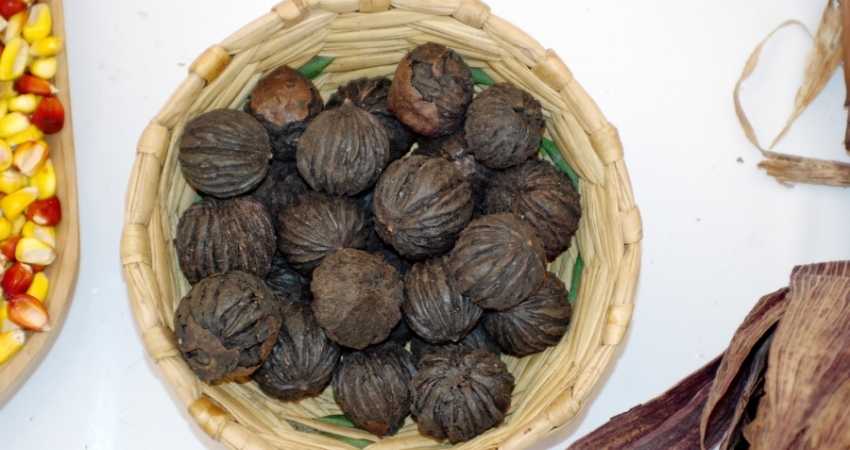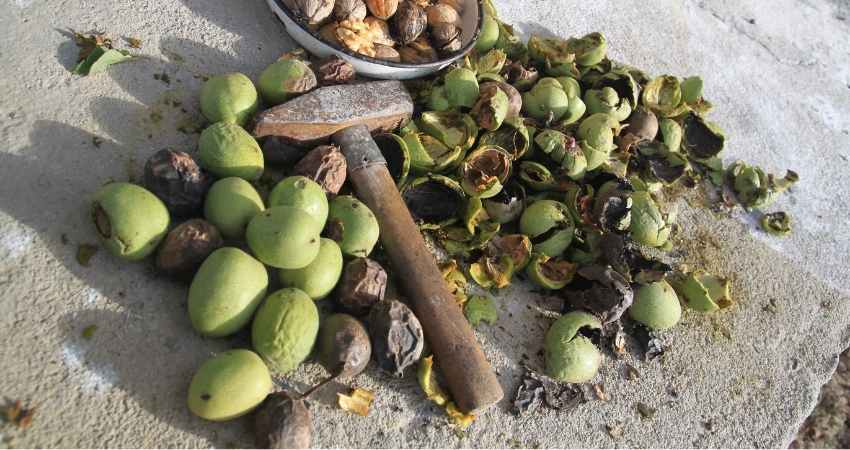How to Forage Black Walnuts: The Complete Guide
Finding good black walnuts in stores is difficult, but finding them in the woods can be easy. So you’ll want to know, how to forage black walnuts.
To forage black walnuts, you’ll have to travel to the midwest USA. The nuts grow on trees at the edges of forests. Walk along these areas starting in mid-summer, and collect the fallen green, yellow, and black hulls. After that, let the nuts ripen and break the hulls open to reveal the meat inside.
In this article, we will discuss how to forage the nuts, where they grow, and when to pick them.
It’s hard to find good black walnuts in the local store. If you’re looking to purchase some, Amazon has a large variety for cheaper which you can check out right here, Black walnuts.
Disclaimer: Some links in this article are affiliate links which means I may earn a small commission at no extra cost to you. As an Amazon associate I earn from qualifying purchases.

How to Forage Black Walnuts
Where Do Black Walnuts Grow?
Black walnuts can grow throughout many regions of North America1. However, the most common places to find the nuts in the U.S. are in the mid and eastern states. The trees have also been cultivated in Hawaii, though they are not native to the area.
Some of the best states to forage black walnuts are:
- Michigan
- South Dakota
- Northern Florida
- Central Texas
- Minnesota
- Southern Wisconsin
- Southern Michigan
- Western Massachusetts
- Northern Connecticut
- Mississippi
- Arkansas
Within these areas, the trees like to grow on the edges of forests, fields, and roadsides so that they can get the most sun. The tree can survive in the shade; however, it won’t produce any fruit.
When to Best Pick Them?
The best time to collect black walnuts is from mid-summer to late-fall, as the nuts drop to the ground. The later in the year you forage the nuts, the riper they will be. You do run the risk of others having collected most of the nuts, though.
Foraging any food is a fun, rewarding experience. It can help you to appreciate your food on a deeper level. Plus, getting outside into fresh air and nature is proven to be good for your mental health2.
Below we will take you through how to forage black walnuts.
Foraging: Do Your Research
The first step (which you’re already doing!) is to do your research. You want to make sure that you’re going to the right location at the right time of year. If you’re heading to Wisconsin in October, you’re on the right track.
Collect Your Equipment
Next, you’ll need to get your equipment ready for the forage. There isn’t much needed, just a large bucket and a good pair of gloves. You should also wear some clothes you don’t care about, as the walnuts will stain if their hull is cracked.
Layers, rain gear, and gumboots are also great things to have in your vehicle, as the autumnal weather can be unpredictable.
Forage
Once you’ve decided on where you will be hunting for walnuts and have put on your gear, you can begin to forage. The nuts will be greenish-yellow in color and will have fallen onto the ground. There is no point in picking these nuts from the trees, as they won’t have had a chance to ripen yet.
Collect as many of these nuts as you can. You may want to bring two or three buckets, as some of the hulls can be the size of tennis balls and will fill your pail quickly.

Hulling Black Walnuts
Once you have collected enough nuts to fill your heart’s desire, you can return home. Be careful not to touch anything with your gloves or the clothes you were wearing. The juice of the black walnuts will stain anything and everything that it comes in contact with.
If the walnuts you’ve collected are very green, you will have to leave them for a few days or even weeks to ripen. Don’t wash the nuts when you get home, as there are bugs on them that are vital to the hulling process.
Fly larvae will bury into the hulls of the nuts and digest it. The bugs won’t enter the nuts themselves, but they will help to soften the shells, so they are easier to remove later.
Once the nuts have ripened (you can tell by how soft they are to the touch), then you can hull them. It’s best to process the nuts outside as they will be very messy.
You can use a small mallet to hit the nut so that the hull cracks. If the bugs have done their job, it will be very simple to peel the hulls off at this point.

Wash the Walnuts
As you peel the walnuts, you should place them in a big bin of water. The nuts will be covered in black goop and maybe some bugs, so you’ll want to wash them thoroughly.
When you do wash the nuts, don’t dump the water in your garden. Black walnut trees produce a chemical known as juglone, and it can potentially kill the other plants in your garden3.
Washing the walnuts will probably take a few attempts, as the grooves in the shells tend to hold onto dirt and muck.
Dry Your Bounty
It’s necessary to dry your walnuts before you eat them so that the water does not fester and create mold in the nutmeat. Dry nuts are also much easier to crack.
If you have space, lay the nuts out in a single layer on a cookie sheet, indoors. This will allow airflow underneath and around the nuts so that they dry faster.
The nuts will take about a week to dry fully. Keep them in a safe place during this time; otherwise, your entire collection will be taken by hungry squirrels.
Crack and Enjoy
Once your walnuts are completely dry, you can do with them as you wish. Some people roast their nuts, but fresh black walnuts are so delicious, there really is no need.
The nuts are notoriously difficult to crack, so you may want to invest in a tool.
If you have any questions to ask me about this article don’t hesitate to comment below or email us. You can find an email on our contact page.
Read Next
Will Mango Make You Fat? Mango Myths & Facts Revealed
22 Best Anti-Aging Fruits for Looking & Feeling Younger
These Are the Mushrooms With the Most Protein
- USDA: Black Walnut [↩]
- National Center for Biotechnology Information: The great outdoors? Exploring the mental health benefits of natural environments [↩]
- Iowa State University: Black Walnut: The Killer Tree [↩]
